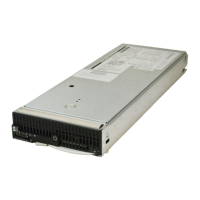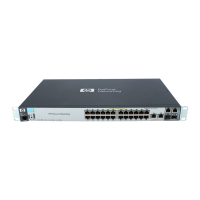Fabric OS Administrator’s Guide 113
53-1002745-02
Routing overview
4
FSPF makes minimal use of the ISL bandwidth, leaving virtually all of it available for traffic. In a
stable fabric, a switch transmits 64 bytes every 20 seconds in each direction. FSPF frames have
the highest priority in the fabric. This guarantees that a control frame is not delayed by user data
and that FSPF routing decisions occur very quickly during convergence.
FSPF guarantees a routing loop-free topology at all times. It is essential for a fabric to include many
physical loops because, without loops, there would not be multiple paths between switches, and
consequently no redundancy. Without redundancy, if a link goes down, part of the fabric is isolated.
FSPF ensures both that the topology is loop-free and that a frame is never forwarded over the same
ISL more than once.
FSPF calculates paths based on the destination domain ID. The fabric protocol must complete
domain ID assignments before routing can begin. ISLs provide the physical pathway when the
Source ID (SID) address has a frame destined to a port on a remote switch Destination ID (DID).
When an ISL is attached or removed from a switch, the FSPF updates the route tables to reflect the
addition or deletion of the new routes.
As each host transmits a frame to the switch, the switch reads the SID and DID in the frame
header. If the domain ID of the destination address is the same as the switch (intra-switch
communications), the frame buffer is copied to the destination port and a credit R_RDY message is
sent to the host. The switch only needs to read word zero and word one of the Fibre Channel frame
to perform what is known as cut-through routing. A frame may begin to emerge from the output
port before it has been entirely received by the input port. The entire frame does not need to be
buffered in the switch.
If the destination domain ID is different than the source domain ID, then the switch consults the
FSPF route table to identify which local E_Port provides the Fabric Shortest Path First (FSPF) to the
remote domain.
Fibre Channel NAT
Within an edge fabric or across a backbone fabric, the standard Fibre Channel FSPF protocol
determines how frames are routed from the source Fibre Channel (FC) device to the destination FC
device. The source or destination device can be a proxy device.
Fibre Channel fabrics require that all ports be identified by a unique port identifier (PID). In a single
fabric, FC protocol guarantees that domain IDs are unique, and so a PID formed by a domain ID and
area ID is unique within a fabric. However, the domain IDs and PIDs in one fabric may be duplicated
within another fabric, just as IP addresses that are unique to one private network are likely to be
duplicated within another private network.
In an IP network, a network router can maintain network address translation (NAT) tables to replace
private network addresses with public addresses when a packet is routed out of the private
network, and to replace public addresses with private addresses when a packet is routed from the
public network to the private network. The Fibre Channel routing equivalent to this IP-NAT is the
Fibre Channel network address translation (FC-NAT). Using FC-NAT, the proxy devices in a fabric can
have PIDs that are different from the real devices they represent, allowing the proxy devices to have
appropriate PIDs for the address space of their corresponding fabric.
